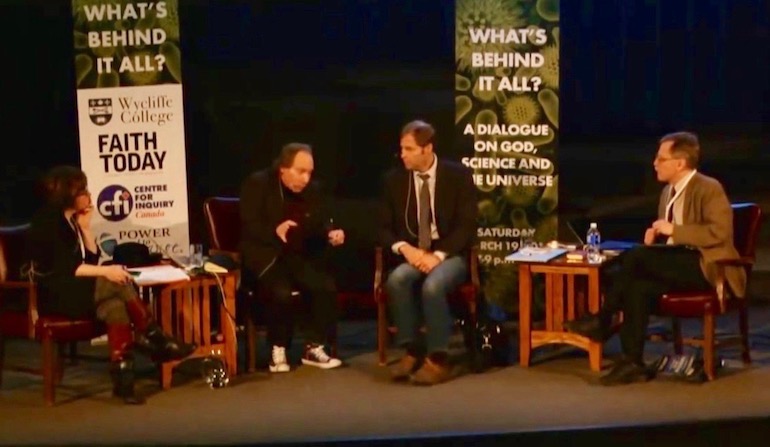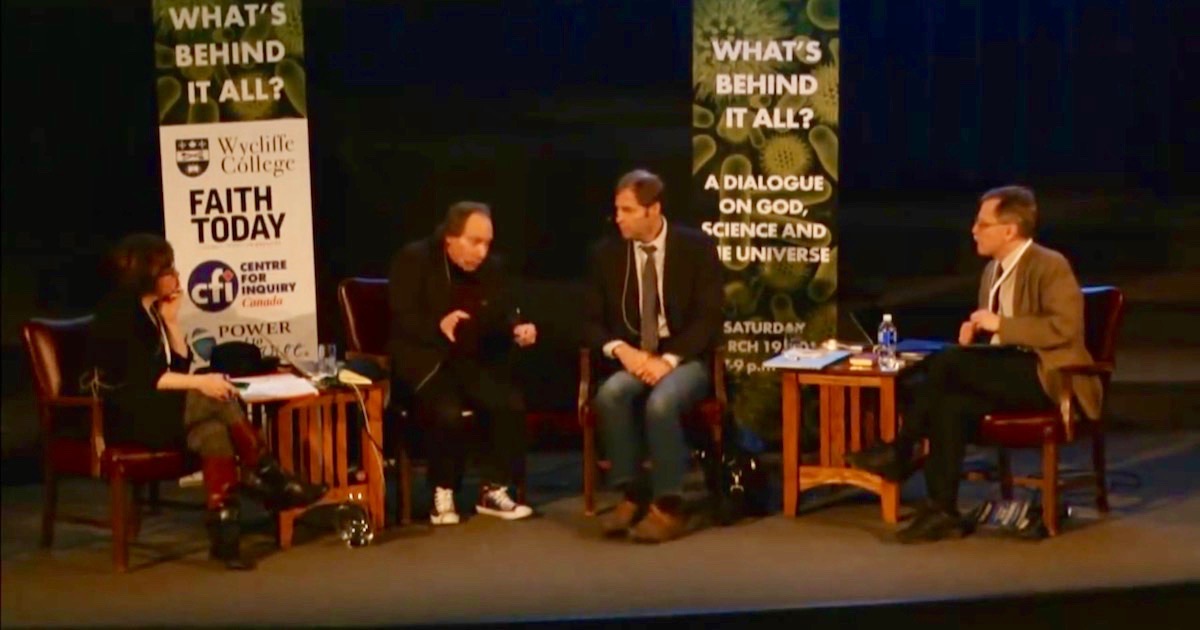 Evolution
Evolution
 Faith & Science
Faith & Science
 Intelligent Design
Intelligent Design
Examining Critiques of Theistic Evolution, a Year After the Volume’s Publication


The book Theistic Evolution: A Scientific, Philosophical, and Theological Critique has been out for about a year now, giving detractors of intelligent design ample time to challenge its arguments. Their responses have followed the same pattern we have seen with previous publications. For years, critics have proven incapable of meaningfully challenging the substance of the core design arguments. So in responding to written works by ID proponents, they have often misrepresented the authors’ meaning, distorted the underlying science, and misdirected the public’s attention away from the actual evidence.
A Subconscious Transaction
This approach is not entirely unexpected from vociferous atheists such as Donald Prothero who defend undirected evolution out of a religious zeal to preserve their philosophical framework. However, the negative responses from some Christians and people of other religious beliefs have appeared to many as much less expected. Yet their reactions are actually quite understandable. As I described in a previous article, the secular academy offers people of faith acceptance if they commit to surrendering their right to critically evaluate secular creation stories related to the origin and development of life. In addition, they must commit to suppressing any evidence they encounter for direct design in biology. This transaction is not usually made consciously, but it transpires at the level of the subconscious as the result of constant social pressure accompanied by the threat of ridicule and other forms of punishment.
I have followed with particular interest the critiques from Christians who subscribe to various versions of theistic evolution and evolutionary creationism. I believe that most of these critics desire to fairly represent the evidence. Yet their absolute commitment to defending the materialist framework for science has resulted in a distortion in how they perceive reality. As a consequence, their attacks have often followed the same patterns as those of their secular colleagues.
A clear example is a review by Denis Lamoureux of the theistic evolution (TE) book. In the review, Lamoureux misrepresents both the book’s content and the policies of Discovery Institute. Equally striking, on a previous occasion Lamoureux participated in a debate with atheist Lawrence Krauss and Stephen Meyer where he teamed up with Krauss to attack Meyer’s argument for design related to the rarity of proteins. Lamoureux’s counterargument to Meyer was based on the story of the sudden appearance of the enzyme nylonase, but that story is a complete myth.
Orphan Genes
Another illuminating case is a series of courteous critiques of the TE book by Randy Isaac. He is former president of the American Scientific Affiliation (ASA), which is a premier organization for scientists who are Christian. In one post at the ASA website, Isaac challenges the evidence cited in the book that the genomes of numerous species and genera contain high percentages of orphan (taxonomically restricted) genes. These genes strongly challenge current evolutionary theory, including, as the book notes, the textbook Tree of Life (TOL) pattern. As French geneticist Didier Raoult argues, “The TOL is…contrary to our current knowledge. The analysis of bacterial genomes shows that between 10 and 15% of the genes of each species has no equivalent in other species” (2012, p. 12).
While evolutionary hypotheses have been proposed to account for the rapidly growing number of taxonomically restricted, or orphan DNA sequences, none is widely accepted as sufficient. Moreover, taxonomically restricted genes (TRGs) were not predicted by standard evolutionary theory, and thus came as a great surprise when whole genome DNA sequencing began in the mid 1990s. UC Davis evolutionary biologist Brian Johnson noted recently (2018, p. 3) that “the question of the general importance of TRGs has never been considered because no one has pointed out how many fundamental biological processes are lineage specific in nature.”
Isaac, however, mistakenly claims that TRGs are actually not that common, which is simply false. Numerous studies, in organisms ranging from bacteria to insects, mollusks, and trees, show the astonishing abundance of TRGs. Isaac would have easily recognized his error if he had looked up the cited references.
Waiting Times
In another post Isaac attempts to minimize the mathematical challenges described in the TE book for attaining the numerous coordinated mutations needed to evolve complex adaptations in allowed timeframes. His critique is based on an article by Wilf and Ewens which argues that the time required for acquiring a given number of mutations scales with the number logarithmically, so more than sufficient mutations would have been available for any transformation. Unfortunately, their underlying model includes numerous implausible features, such as assuming that mutations needed for adaptations are never lost through genetic drift. In contrast, a realistic model by Chatterjee et al. demonstrates that the time required to accumulate multiple mutations in the same individual scales with the number not logarithmically but exponentially. In addition, the waiting time for just two coordinated mutations to spread throughout a population (reach fixation) often exceeds available timeframes for major transformations in larger mammals (e.g., land-bound animal to whale), and fixation for two neutral mutations at specific locations in DNA requires a waiting time of millions of years even for insects. As a result, the undirected evolution of nearly all complex innovations is mathematically implausible.
Wilf and Ewens’s model also fails to differentiate between mutations which could potentially drive macroevolution and those which could never contribute to any large-scale architectural changes (e.g., transforming a shrew-like mammal into a bat). The standard example of the former category mentioned in most textbooks is the mutant four-winged fruit fly. However, the addition of the extra wings results not from a mutation that occurs naturally, but rather is the product of geneticists’ engineering three coordinated mutations. Moreover, the additional wings are nonoperational, so the mutant would never survive outside of a laboratory. If a crippled insect is the best available example of evolution in action, then no mutation has likely ever been observed that could clearly propel any major transformation.
Isaac could have easily recognized the flaws in Wilf and Evans’s research if he had retained his right to critically evaluate evolutionary claims. Instead, his philosophical commitments drove him to ignore the credible journal articles cited in the TE book. Moreover, he appealed to research that was so flawed that it would likely never have been published if not for the desperate need to rationalize away the mathematical challenges to neo-Darwinism.
Generating New Information
In other posts Isaac addresses the core intelligent design axiom that large amounts of information cannot be created by any natural process. He references articles by Dennis Venema to discredit this claim. However, Venema distorts the actual design argument. He does so by implying that the claim is that no new information can be created. In reality, ID theorists recognize that some information can be generated through various means, but the amount cannot dramatically exceed what is achievable through a random search. For instance, the immune system is capable of producing sufficiently large numbers of randomized amino-acid sequences in target regions of antibodies to stumble upon those which can bind to an invading pathogen. The system works because the required information for binding is sufficiently small compared to the number of generated antibodies. However, the information needed to evolve any complex innovation or even a novel protein exceeds all available probabilistic resources (e.g., number of organisms which have ever existed).
The failure to make this distinction is the basis for standard arguments that generating new information is not a hurdle for evolutionary processes. For instance, counterexamples cited by Venema involve the formation of very small quantities of information, such as that associated with the immune system or the creation of a new binding site in an existing protein. Venema’s other arguments involve circular reasoning or misinterpretations of cited literature, particularly relating to the rarity of protein folds. All such critiques collapse when the actual ID arguments and relevant research are properly understood.
Photo: Atheist Lawrence Krauss and Christian theistic evolution Denis Lamoureux (r.) team up in a debate against Stephen Meyer, via Wycliffe College, University of Toronto (screen shot).
